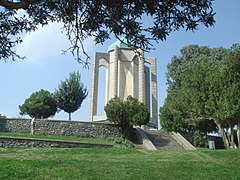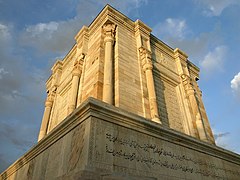Society for the National Heritage of Iran

The Society for the National Heritage of Iran (SNH;
Iran in 1922 was influenced by internal and external forces, and the SNH reflects this tug of war between what was the external forces mainly from Europe, and internal/social factors.Background
Early 1900s were time of discovery and archeological exploration in Iran. It was also time of social and political change. The Persian Constitutional Revolution of 1906 had rocked the perception of the absolute control of the king in society. It created an Iranian Parliament and had reduced the monarch's power.[3] The Constitutional Revolution was in some ways the first political expression of the public sphere, that the poets and the literati, now completely out of the Qajar court had drafted with diligence and steadfast determination.[3] The foreign interest in archeology and Iranian history has also peaked with several well known scholars from France, England and Russia vying for control. France in particular was very influential in preservation of the Iranian artifacts and in fact the involved French parties exhibited both interest in Persian history, and archeology and at the same time feared that these artifacts would be dispersed and sold.[1] France would play a critical role in protection of Iranian artifacts but ironically it also wanted an absolute monopoly for all Persian artifacts in Iran.[4] Renown French archeologist Jacques de Morgan in fact wanted to preserve Persian art to the point that in 1897 proposed to the Naser al-Din Shah the idea of creation of a National Archeological museum in Tehran.
In spite of his pure interest in Persian artifacts in Iran, after the first few seasons of archeological excavations in Iran yielded numerous rare finds, de Morgan changed his opinion and advocated an absolute French monopoly on all finds and proposed transfer of all Iranian discoveries to France.
It was in this context that after the
Goals and achievements
The goal of the SNH was in a general sense to preserve, protect and promote Iranian patrimony but in a specific sense it focused on three aspects: 1) Establishing a museum and library in Tehran and Ending the prestigious but monopolized French archeology in Iran, 2) proper identification, registration of all artifacts and monuments that were in need of repair or catalog, and 3) preparing and recording a list of all antiques in possession of government or other groups pertaining to ancient Iran's history.[1][2] The group would be instrumental in eliciting the proper funds from the Iranian Parliament in order to achieve the aforementioned goals.
Architectural Projects
The group was able to secure enough funds from the Iranian parliament to remodel and build the
-
Tomb of Saadi Shirazi in Shiraz, Iran
-
Baba Tahir's mausoleum in Hamedan, Iran
-
Ferdowsi's mausoleum in Tus, Iran
Archeological Monopoly
Although not directly involved in ending the French monopoly, the SNH was part of a broader national movement to end French monopoly in Iran and to nationalize the ownership of the artifacts. The group invited speeches by such archeological figures at the time as Ernst Herzfeld head of German Institute of Oriental Archeology, and the well known American archeologist Arthur Upham Pope in form of conferences.[1] The first publication of the group was in fact made with help of Herzfeld and was a list of all historical archeological sites in Iran.[2] Reza Shah did not interfere with the works of Ernst Herzfeld or the French archeologists neither did he take sides, but he did ensure that their excavations go smooth and that Persian monuments are recovered with the best portion of them going to Iranian ownership.[1] The combined efforts of the SNH and other cultural and historical groups at the time led to Iran having the majority monopoly over the recovery of its own artifacts and discoveries.
-
Outer facade of the National Museum of Iran.Sassanian architectureis used.
Linguistic Influence
Although primarily an architectural and political entity, the SNH also advocated or assisted individuals who had hoped for a revitalization of the Persian language. One major move at the time of SNH was de-listing Arabic loan words and replacing them with old or new Persian words. Even though SNH was involved in publications and advocacy of a more cohesive Persian language, it was intellectuals such as Sadiq Kiya and Ibrahim Purdavus who through their publications, and their focus on Ferdowsi's Shahnameh created a Persian vocabulary that was mainly New, Middle, or Old Persian in origin.[6][7] Nonetheless through its publications SNH was a force behind removing of foreign words from Persian.
Legacy
Nearly every significant Persian poet whose mausoleum is in Iran has benefited from SNH's involvement. SNH has been critical in protection and identification of Iranian artifacts and language as well. Iran having a significant Pre-Islamic history, as well an equally significant history after Islam, has always suffered from a dichotomy in its loyalties between what is essentially a desire for heritage and one that is a desire for religion.[8] The political systems in Iran seem not to be immune to this dichotomy as well. The SNH and indeed the Pahlavi dynasty seem to embrace the Iranian identity[1] but ignore the Islamic identity of Iran, whilst the current regime in Iran, headed by Muslim clerics, seems to ignore or downplay Iranian identity in favor of an Islamic identity.
Archeological works
The following table denotes the list of mausoleums erected or repaired/updated by the SNH in Iran:
| Individual | Location of Mausoleum | Current state | Date of construction | Details of changes/improvements |
|---|---|---|---|---|
| Ferdowsi | Tus |  |
1934 | The old tomb was a minor dome-shaped structure with foundation problems. A new cubical tomb was erected |
| Saadi Shirazi | Shiraz |  |
1952 | The old tomb was in disarray and had foundation problems |
| Baba Tahir | Hamedan |
 |
1970[9] | The old edifice was small, and had structural issues |
| Omar Khayyam | Nishapur | 1962-3 | Construction of the new tomb complex with the surrounding Persian Garden
| |
| Nader Shah | Mashhad |  |
1940s | Extensive repair and addition of new structures and sculptures under order of Reza Shah in the 1940s, mainly to restore the structure that has sustained damage from the Russian aerial bombings of 1912[10] |
| Avicenna | Hamedan |
 |
1952[11] | Construction of a whole new mausoleum. Mausoleum placed in the center of the city in a Roundabout now called "Abu Ali roundabout" (Persian: میدان ابو علی سینا "Meydaan-e Abu Ali Sina")[11] |
| Kamal-ol-molk | Nishapur |  |
1940 | Construction of a new tomb |
| Attar of Nishapur | Nishapur |  |
1950s | Repair of the existing tomb built by Ali Sher Nava'i in the 16th century[12] |
Saeb Tabrizi
|
Isfahan | 1950s | Essentially a new construction of existing tomb | |
| Ruzbihan Baqli | Shiraz | - | 1940-1950s | Extensive repair and addition |
| Molla Hossein Vaez Kashefi | Sabzevar |  |
1940-1950s | Repair and addition |
See also
- Ministry of Cultural Heritage, Handicrafts and Tourism
References
- ^ ISBN 9781135125530.
- ^ a b c d e f g h i Sadiq, I (15 Dec 1985). "Anjoman-e Āsar-e Melli". Encyclopedia Iranica. Columbia University. Retrieved 24 April 2014.
- ^ ISBN 9780674070615.
- ISBN 9780870996511.
- ISBN 9781136673412.
- ISBN 9780932885289.
- ISBN 9004039023.
- ISBN 9781409489269.
- ISBN 9781841621234.
- ISBN 9781884964039.
- ^ ISBN 9781841622897.
- ISBN 9780980858396.





